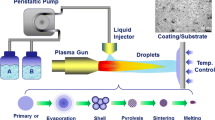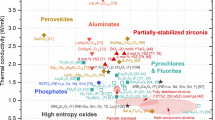Abstract
The primary function of thermal barrier coatings (TBCs) is to insulate the underlying metal from high temperature gases in gas turbine engines. As a consequence, low thermal conductivity and high durability are the primary properties of interest. In this work, the solution precursor plasma spray (SPPS) process was used to create layered porosity, called inter-pass boundaries, in yttria-stabilized zirconia (YSZ) TBCs. IPBs have been shown to be effective in reducing thermal conductivity. Optimization of the IPB microstructure by the SPPS process produced YSZ TBCs with a thermal conductivity of 0.6 W/mK, an approximately 50% reduction compared to standard air plasma sprayed (APS) coatings. In preliminary tests, SPPS YSZ with IPBs exhibited equal or greater furnace thermal cycles and erosion resistance compared to regular SPPS and commercially made APS YSZ TBCs.











Similar content being viewed by others
Abbreviations
- k :
-
Thermal conductivity, W/mK
- α:
-
Thermal diffusivity, m2/s
- c p :
-
Specific heat, J/gK
- ρ:
-
Density, kg/m3
- TBC:
-
Thermal barrier coatings
- SPPS:
-
Solution precursor plasma spray
- IPB:
-
Inter-pass boundaries
- Y(F/P)SZ:
-
Yttria(-fully/partially)-stabilized zirconia
- APS:
-
Air plasma spray
- FOD:
-
Foreign object damage
- OEM:
-
Original equipment manufacturer
- HVOF:
-
High velocity oxygen fuel
- LPPS:
-
Low pressure plasma spray
- SEM:
-
Scanning electron microscope
- FEA:
-
Finite element analysis
- EB-PVD:
-
Electron beam physical vapor deposition
References
N.P. Padture, M. Gell, and E.H. Jordan, Thermal Barrier Coatings for Gas-turbine Engine Applications, Science, 2002, 296(5566), p 280-284
A. Maricocch, A. Bartz, and D. Wortman, PVD TBC Experience on GE Aircraft Engines, J. Therm. Spray Technol., 1997, 6(2), p 193-198
C.H. Liebert and S. Stecura, Ceramic Thermal Protective Coating Withstands Hostile Environment of Rotating Turbine Blades, NASA Tech Briefs, NASA-LeRC, Cleveland, OH, 1975
S.J. Grisaffe, S.R. Levine, and J.S. Clark, Thermal Barrier Coatings, National Aeronautics and Space Adminstration, NASA-LeRC, Cleveland, OH, 1978
C.H. Liebert and R.A. Miller, Ceramic Thermal Barrier Coatings, Ind. Eng. Chem. Prod. Res. Dev., 1984, 23(3), p 344-349
R.A. Miller, Thermal Barrier Coatings for Aircraft Engines: History and Directions, J. Therm. Spray Technol., 1997, 6(1), p 35-42
R. Vassen, X.Q. Cao, F. Tietz, D. Basu, and D. Stöver, Zirconates as New Materials for Thermal Barrier Coatings, J. Am. Ceram. Soc., 2000, 83(8), p 2023-2028
D.R. Clarke and C.G. Levi, Materials Design for the Next Generation Thermal Barrier Coatings, Annu. Rev. Mater. Res., 2003, 33(1), p 383-417
H. Lehmann, D. Pitzer, G. Pracht, R. Vassen, and D. Stöver, Thermal Conductivity and Thermal Expansion Coefficients of the Lanthanum Rare-Earth-Element Zirconate System, J. Am. Ceram. Soc., 2003, 86(8), p 1338-1344
C.G. Levi, Emerging Materials and Processes for Thermal Barrier Systems, Curr. Opin. Solid State Mater. Sci., 2004, 8(1), p 77-91
D. Stöver, G. Pracht, H. Lehmann, M. Dietrich, J.E. Doring, and R. Vassen, New Material Concepts for the Next Generation of Plasma-Sprayed Thermal Barrier Coatings, J. Therm. Spray Technol., 2004, 13(1), p 76-83
A.G. Evans and C.G. Levi, Enhanced Zirconia Thermal Barrier Coating Systems, Proc. Inst. Mech. Eng. A, 2006, 220(1), p 85-92
X. Ma, F. Wu, J. Roth, M. Gell, and E.H. Jordan, Low Thermal Conductivity Thermal Barrier Coating Deposited by the Solution Plasma Spray Process, Surf. Coat. Technol., 2006, 201(7), p 4447-4452
W. Ma, M.O. Jarligo, D.E. Mack, D. Pitzer, J. Malzbender, R. Vassen, and D. Stöver, New Generation Perovskite Thermal Barrier Coating Materials, J. Therm. Spray Technol., 2008, 17(5), p 831-837
W. Ma, D. Mack, J. Malzbender, R. Vassen, and D. Stöver, Yb2O3 and Gd2O3 Doped Strontium Zirconate for Thermal Barrier Coatings, J. Eur. Ceram. Soc., 2008, 28(16), p 3071-3081
W. Ma, D.E. Mack, R. Vassen, and D. Stöver, Perovskite-Type Strontium Zirconate as a New Material for Thermal Barrier Coatings, J. Am. Ceram. Soc., 2008, 91(8), p 2630-2635
R. Vassen, A. Stuke, and D. Stöver, Recent Developments in the Field of Thermal Barrier Coatings, J. Therm. Spray Technol., 2009, 18(2), p 181-186
R. Vassen, M.O. Jarligo, T. Steinke, D.E. Mack, and D. Stöver, Overview on Advanced Thermal Barrier Coatings, Surf. Coat. Technol., 2010, 205(4), p 938-942
J.A. Krogstad, M. Lepple, and C.G. Levi, Opportunities for Improved TBC Durability in the CeO2-TiO2-ZrO2 System, Surf. Coat. Technol., 2013, 221(4), p 44-52
C.G. Levi, J.W. Hutchinson, M.H. Vidal-Sefif, and C.A. Johnson, Environmental Degradation of Thermal Barrier Coatings by Molten Deposits, MRS Bull., 2012, 37(10), p 932-941
A.D. Jadhav, N.P. Padture, F. Wu, E.H. Jordan, and M. Gell, Thick Ceramic Thermal Barrier Coatings with High Durability Deposited Using Solution Precursor Plasma Spray, J. Mater. Sci. Eng. A, 2005, 405(1), p 313-320
A.D. Jadhav, N.P. Padture, E.H. Jordan, M. Gell, P. Miranzo, and E.R. Fuller, Jr., Low-Thermal-Conductivity Plasma-Sprayed Thermal Barrier Coatings with Engineered Microstructures, Acta Mater., 2006, 54(12), p 3343-3349
M. Gell, E.H. Jordan, M. Teicholz, B.M. Cetegen, N.P. Padture, L. Xie, D. Chen, X. Ma, and J. Roth, Thermal Barrier Coatings Made by the Solution Precursor Plasma Process, J. Therm. Spray Technol., 2008, 17(1), p 124-135
R.E. Taylor, Thermal Conductivity Determination of Thermal Barrier Coatings, J. Mater. Sci. Eng. A, 1998, 245(2), p 160-167
B. Borawski, J. Singh, J.A. Todd, and D.E. Wolfe, Multi-layer Coating Design Architecture for Optimum Particulate Erosion Resistance, Wear, 2011, 271(11), p 2782-2792
D.E. Wolfe, B.M. Gabriel, and M.W. Reedy, Nanolayer (Ti,Cr)N Coatings for Hard Particle Erosion Resistance, Surf. Coat. Technol., 2011, 205(19), p 4569-4576
F. Wu, E.H. Jordan, X. Ma, and M. Gell, Thermally Grown Oxide Growth Behavior and Spallation Lives of Solution Precursor Plasma Spray Thermal Barrier Coatings, Surf. Coat. Technol., 2008, 202(9), p 1628-1635
J.R. Davis, Environmental Stability-Bond Coat Oxidation, Handbook of Thermal Spray Technology, Thermal Spray Society and ASM International, 2004, p 270
C.K. Muoto, E.H. Jordan, M. Gell, and M. Aindow, Identification of Desirable Precursor Properties for Solution Precursor Plasma Spray, J. Therm. Spray Technol., 2011, 20(4), p 802-816
D. Chen, E.H. Jordan, and M. Gell, Effect of Solution Concentration on Splat Formation and Coating Microstructure Using the Solution Precursor Plasma Spray Process, Surf. Coat. Technol., 2008, 202(10), p 2132-2138
R. Rampon, O. Marchand, C. Filiatre, and G. Bertrand, Influence of Suspension Characteristics on Coatings Microstructure Obtained by Suspension Plasma Spray, Surf. Coat. Technol., 2008, 202(18), p 4337-4342
S.A. Langer, E.R. Fuller, Jr., and W.C. Carter, OOF: An Image-Based Finite-Element Analysis of Material Microstructures, Comput. Sci. Eng., 2001, 3(3), p 15-23
A. Ozturk and B.M. Cetegen, Modeling of Plasma Assisted Formation of Precipitates in Zirconium Containing Liquid Precursor Droplets, J. Mater. Sci. Eng. A, 2004, 384(1), p 331-351
M.P. Bacos, J.M. Doraux, S. Landais, O. Lavigne, R. Mevrel, M. Poulain, C. Rio, and M.-H. Vidal-Setif, 10-Year-Activities at Onera on Advanced Thermal Barrier Coatings, Aerosp. Lab J., 2011, AL03-04(3), p 1-14
Acknowledgments
This research is supported by the US Department of Energy, National Energy Technology Lab through the University Turbine Systems Research (UTSR) program award DE-FE-0007382. Special thanks to NETSZCH Instruments for doing parallel measurements to validate our laser-flash system. The authors would also like to thank Prof. Douglas Wolfe at Penn State University for the erosion testing.
Author information
Authors and Affiliations
Corresponding author
Rights and permissions
About this article
Cite this article
Jordan, E.H., Jiang, C., Roth, J. et al. Low Thermal Conductivity Yttria-Stabilized Zirconia Thermal Barrier Coatings Using the Solution Precursor Plasma Spray Process. J Therm Spray Tech 23, 849–859 (2014). https://doi.org/10.1007/s11666-014-0082-5
Received:
Revised:
Published:
Issue Date:
DOI: https://doi.org/10.1007/s11666-014-0082-5




